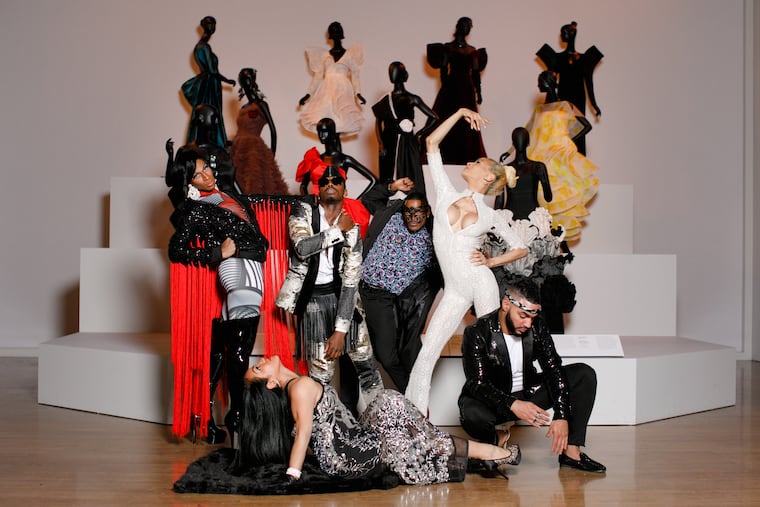Far from black-tie, this Art Museum ball celebrates LGBTQ ballroom culture
Philly's ballroom community spent a year collaborating with Art Museum staffers to present a runway show with original designs, plus voguing workshops and a special exhibit on Philly's ballroom culture.

As the Philadelphia Museum of Art prepares to host an extravagant ball on Friday, organizers are not stocking up on champagne or fancy hors d’oeuvres. This ball, a community project that’s been a year in the works, was designed to celebrate Philadelphia’s ballroom scene — an LGBTQ subculture anchored by performance, built by people of color.
Instead of a parade of satin evening gowns, there will be a runway show, “Fabulous Fashions of Ballroom,” featuring original designs carefully crafted from sequins, leather, lace, and faux fur, inspired by the museum’s current fashion exhibit. The 25 creators of the designs will float down the Great Stairs in stilettos and velvet loafers, synced to a soundtrack curated by MikeQ, a New Jersey DJ who has spent a decade championing ballroom.
And instead of waltzing, there will be voguing, a style of dance that flamboyantly imitates the poses struck by models on the catwalk. Don’t know how? No worries. Ball-goers can sign up for a 20-minute session on the five elements of voguing — hands, catwalk, duckwalk, spin and dip, and floor — taught by the experts themselves in the Arms and Armor gallery.
To bring “Final Fridays: Werk It!” to fruition, the Art Museum spent a year working closely with POSSE Project, a team of researchers studying behavioral-intervention methods in Philly’s house and ballroom community.
Funded by the National Institute for Mental Health and organized by the Children’s Hospital of Philadelphia, POSSE stands for “Promoting Ovah-ness through Safer Sex Education.” (Ovah-ness means “amazing” or “fantastic” in the ballroom community.)
The team of researchers works with young African American men who have sex with men to devise a customized strategy for increasing sexual-health awareness, discouraging risky behavior, and developing mentors within the community. To reach the target audience, CHOP has organized several dance-driven gatherings (better known as Kiki lounges) and ballroom competitions.
The Art Museum ball will be POSSE’s most visible event to date, with roughly 1,000 people expected to attend.
The city’s ballroom community first floated the idea of collaborating two years ago, according to POSSE Project coordinator Bevin Gwiazdowski. They finally connected with the museum a year ago, when staff members recognized that the 2018-19 exhibit Fabulous Fashion: From Dior’s New Look to Now (through March 3) provided the perfect backdrop for a ball.
“The museum is a really outstanding place to have a ball,” said Corey “Ike Lanvin” Jackson, a POSSE Project committee member who helped organize Friday’s event. “For the ballroom gay scene, it’s a really big accomplishment. We’re really proud just to be able to display the fashion that we have alongside the [Fabulous Fashion] exhibit.”
Lanvin said the entire ballroom scene in Philadelphia rallied behind this event. Come Friday evening, he expects to see a wide range of the city’s ballroom community — from young teens to people in their 40s — showing off their fiercest moves on the runway.
“We involved lots of people who have been with ballroom since the beginning and people who have just started,” Lanvin said. “Seeing them bridge that age gap has been really incredible.”
Ballroom culture first took root in the drag balls of the Harlem Renaissance in the 1920s, but it really flourished during the 1970s, when “houses” were created. Houses provided surrogate families for young queer people of color, who were typically estranged from their families and struggling to get by. The groups organized competitions, known as balls, where house members would “walk” or vogue for trophies and prizes.
Ball culture found a foothold in Philadelphia during the late ’70s and early ’80s. Today, there are 12 active houses in the city, such as House of Prodigy and House of Blahnik; 10 of them will be represented at Friday’s event, according to Lanvin. The groups meet up to compete for cash prizes at balls throughout the year. Last November, the popular Gayborhood bar Woody’s started hosting a monthly series of vogue nights.
“I’m hoping that [attendees] will get a little glimpse into the community and see how talented the people who are involved with this community are,” Gwiazdowski said.
Over the last year, POSSE Project members have joined forces with Art Museum staffers to figure out details for the runway show — the centerpiece of the event — such as lighting, staging, and sound. Besides the show and voguing workshops, event attendees can also tour the Fabulous Fashion exhibit with members of the ballroom community.
But the ball is not just a fun, fashion-filled evening. Art Museum educators and members of POSSE Project also wanted to use this opportunity to educate attendees about the ballroom community.
“It was very, very important to us that this not simply be a spectacle,” stressed Emily Schreiner, the curator of education and public programs at the Art Museum. “As a large institution, we are not asking people to perform this identity.”
The extensive collaboration between POSSE Project and the museum led to an exhibit on Philadelphia’s ballroom history, which visitors can explore on Friday. It includes personal accounts from the ballroom community, videos of previous balls, and outfits and accessories worn while walking. There will also be a detailed handout on POSSE Project.
“We’re giving the world a taste of our community at the museum,” Lanvin said. “We’ve been underground for so long, so it’s cool that we get to show people a different community they might have not known about in the LGBTQ scene.”
5 to 8:45 p.m. Friday. Philadelphia Museum of Art, 2600 Benjamin Franklin Pkwy. $18 for adults and seniors, $14 for students with valid ID and youth ages 13-18, free for children under 12. 215-763-8100. philamuseum.org